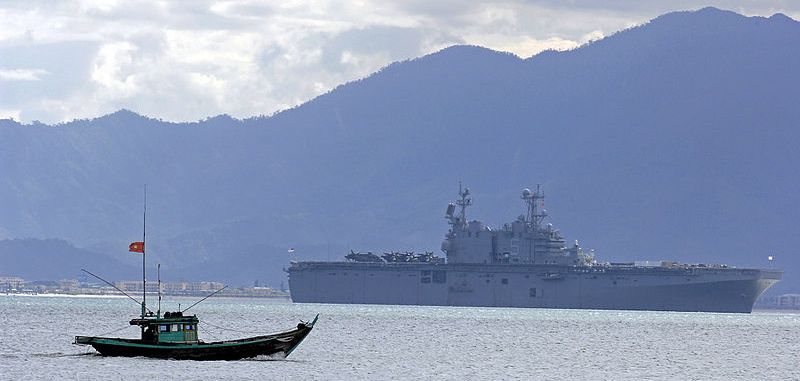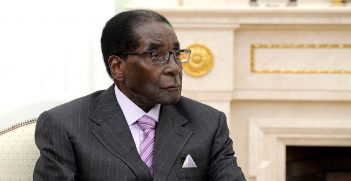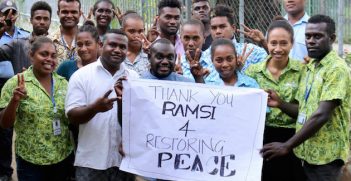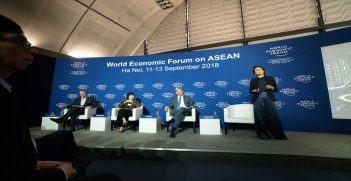A Regional Security Hotspot in the South China Sea

Mounting tensions between Vietnam and China show that the South China Sea continues to be a security hotspot following China’s renewed assertiveness in the region.
The provocative placement of the HYSY-981 oil-drilling rig in contested waters near Vietnam and China’s dispatch of approximately 100 paramilitary and navy ships to protect it in early May ignited Vietnamese public anger which later burst into demonstrations.
China has argued that the sovereignty of the Paracels (known as Xisha to China and Hoang Sa to Vietnam) is undisputed. But in order for a nation’s claim to a territory to be undisputed there cannot be other claimants, the claim must be supported by effective control or administration of the territory and its occupation must be recognised by other nations. China’s claims do not seem to satisfy these conditions, as China and Vietnam have been involved in disputes over the territory in the South China Sea since the 1970s. If it cannot be shown that the Paracels are non-disputed islands, it may not be appropriate for China to consider unilateral acts in the region.
Disputed Claims
China’s use of the ‘nine-dash’ line to show the maximum extent of its claim, including almost the entire body of water in the South China Sea, has attracted critical responses from other regional governments as well as academics. Countries such as Vietnam and the Philippines have rejected the ‘nine-dash’ line arguing that it violates the 1982 United Nations Convention on the Laws of the Sea (UNCLOS). Furthermore some critics have argued that the ‘nine-dash’ line violates maritime law which states that a national boundary has to be stable and defined.
In the past, China has been accused of interpreting legal documents and treaties such as the 1982 UNCLOS to support its historical claims, while paying little respect to differing interpretations put forward by other claimants. In addition, Chinese attempts to alter the status quo in the region unilaterally have also attracted robust criticism from the international community. For example, a joint statement from the Japan-US-Australia Defence Ministers Meetings in late May expressed strong opposition to the use of coercion or force in the disputed seas. In a separate statement ASEAN leaders have expressed similar concerns for the first time since the 1995 ASEAN Foreign Ministerial Statement following the Mischief Reef Incident.
Vietnam’s Position
Rodolfo C Severino, former ASEAN Secretary General and Filipino diplomat, summarises the Vietnamese claim over land features in the South China Sea by virtue of discovery, use and occupation as well, as successor-state to France, on the acts of sovereignty that France carried out in the area since the 1920s. He notes that at the 1951 San Francisco peace conference, Vietnam asserted its claims to the Spratlys and the Paracels without challenge.
Some commentators argue that China has deliberately interpreted Vietnam’s goodwill to China, its main ally against the US during the Vietnam War, as de facto recognition of Chinese sovereignty over the Paracels and the Spratlys. However Vietnam has never communicated any official approval of the inclusion of the two archipelagos within Chinese territory.
The Threat of Further Destabilisation
Beijing has traditionally opposed settling these disputes through multilateral negotiations or legal mechanisms, including arbitration under the Convention, resisting attempts to ‘internationalise’ the dispute. China’s behaviour in the region has generally been assertive, as demonstrated by China’s use of force in its occupation of the Paracels in 1956 and 1974 and the Spratly Islands in 1988 and 1995.
Over the past few years, China’s actions in imposing unilateral fishing bans, cutting the cables of Vietnamese vessels and harassment of other claimants’ fishing have further destabilised the situation and constituted a threat to regional security, including the safety of maritime navigation in the contested waters. Despite international protests following its first oil rig placement, the China National Offshore Oil Corporation has recently announced plans for four new rigs to begin production in the South China Sea later this year.
In Search of a Peaceful Solution
Pending bilateral talks for a peaceful solution, the Vietnamese Coast Guard and Fishery Surveillance Forces have shown relative self-restraint despite China’s recent assertiveness. Meanwhile Vietnamese Prime Minister Nguyen Tan Dzung has said that Vietnam will resort to all available peaceful means, including legal action, to protect the sovereignty of the disputed islands and water. However Vietnamese leaders have not ruled out the possibility of resorting to military action in case Vietnam was forced to defend itself.
It is of utmost importance for regional leaders and scholars to have farsighted vision of this issue. Any ill-thought out action could have detrimental and far-reaching consequences in terms of stability and development in the Asia-Pacific.
Julia Luong Dinh is a PhD student at Department of Government and International Relations at the University of Sydney. She can be reached on luongiir@yahoo.com.





